Mar
21
Tips for Shooting the Moon
Filed Under Science & Astronomy, Photography on March 21, 2008 at 11:32 pm
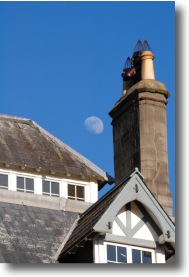 It can be very nice to include the Moon in your shots of buildings or landscapes but it’s not easy. The reality is that the Moon is very small in the sky and that it’s hard to pick up detail on the Moon while also properly exposing your subject. That’s why so many people cheat and get the Moon into their shots using PhotoShop. They stick on a massive zoom lens, shoot the Moon, then stick on a normal lens to shoot their subject and finally combine the two shots into one. If that’s the way you want to do things that’s your call, personally I look at it as cheating and would prefer to do it the hard way and actually capture the Moon and my subject in a single shot.
It can be very nice to include the Moon in your shots of buildings or landscapes but it’s not easy. The reality is that the Moon is very small in the sky and that it’s hard to pick up detail on the Moon while also properly exposing your subject. That’s why so many people cheat and get the Moon into their shots using PhotoShop. They stick on a massive zoom lens, shoot the Moon, then stick on a normal lens to shoot their subject and finally combine the two shots into one. If that’s the way you want to do things that’s your call, personally I look at it as cheating and would prefer to do it the hard way and actually capture the Moon and my subject in a single shot.
[tags]photography, DSLR, the Moon[/tags]
When it comes to capturing the Moon there are three crucial things to bear in mind, Timing is everything, Zoom as much as you can, and be prepared to do a lot of leg work to get your shot perfectly framed.
Timing
In order to get the Moon into your shots you need it low to the horizon. The lower the better. There are only two short windows each day when the Moon is low to the Horizon. These two windows slowly drift through the day getting back to where they started every 29 days. You need to keep an eye on when these windows are if you want to set up that perfect Moon shot. You’ll probably have to scout out your target a few times to see just how low or high will be ideal and then keep an eye on the rise and set times for the Moon for your location. The simplest way to do that is with an astronomy program like the free and cross-platform Stellarium.
Zoom Like Mad
Our eyes play tricks on us when it comes to the Moon, we think it’s quite large but it’s disappointingly tiny really. To hammer this home here’s a wide angle shot of the Moon rising over a Flemish landscape:
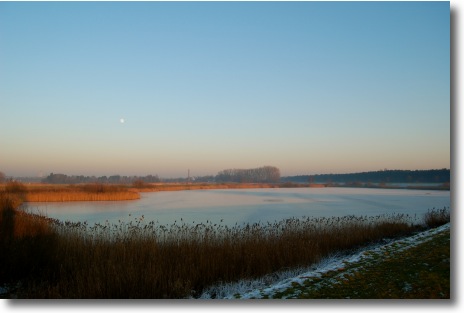
The Moon over a Flemish Landscape at 18mm.
So, at 18mm the Moon looks like a small spot. I still like that shot and still think the Moon adds to it but you certainly can’t say that the Moon is prominent in that shot. So, are things much different when you zoom as far as you can with the standard kit lens that comes with the D40(55mm)? A little, but not much. The image below was taken at the same time as the last example but at the opposite extreme of the zoom on that standard lens, the last one was zoomed all the way out, this one is zoomed all the way in:
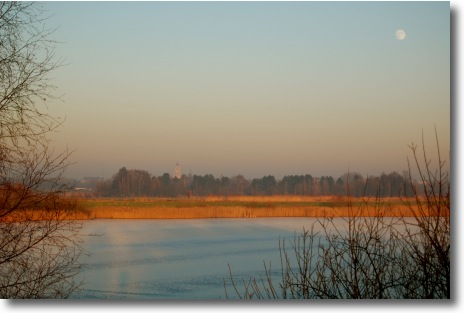
The Moon over a Flemish Landscape at 55mm.
So how far do you have to go before the Moon starts to really become dominant in a shot? You zoom as far as you can. If you’re shooting hand-held then your limit will probably be around 200mm, and if you can and you have a tripod you should try to zoom more.
The shot below was taken at 200mm. The Moon is still very small in the shot but at this size it really starts to catch people’s attention to the point if it potentially being the real subject of the photograph. It’s still far too small to hold your interest in its own, but if you compose your shot carefully you can get nice results.
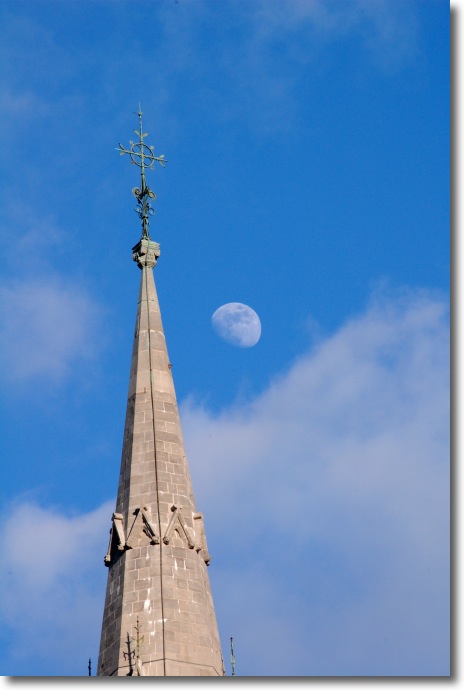
The Moon Beside the Spire of the Gunne Chapel in Maynooth at 200mm.
Finally, take your shots at as high a quality as your camera can. That way you can artificially increase your zoom by cropping. The Image below was taken at 200mm and then cropped.
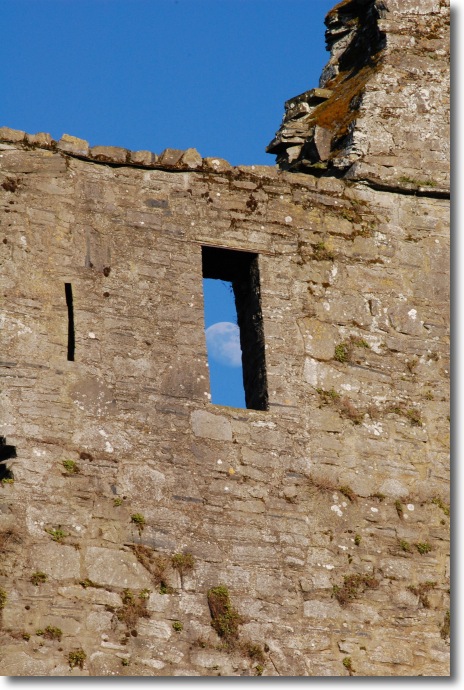
The Moon Through a Windows in the ruins of Maynooth Castle. This shot was taken at 200mm. This image is not cropped.
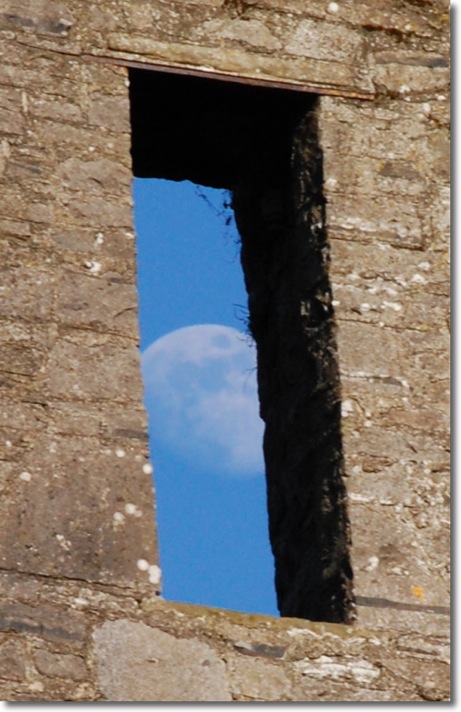
This is a cropped version of the image above.
Don’t be Afraid to Walk
Because the Moon is effectively at infinite distance and because you have no control over it’s position you’re going to have to do a lot of leg-work to get your shot framed just right. It will take a lot of searching to find the perfect spot to shoot from where everything is nicely framed. And if you want to get a few different shots you’re going to have to do a lot of walking. Depending on just how tightly you want to control the composition you may have a lot of searching to do to find that perfect spot. For the shot above with the Moon showing through the Window I had to find the single square meter from which that shot was possible. It took a bit of work and I had to stand in a puddle to get it but I’m glad I took the effort.
Finally, you will also be shocked by how fast the Moon moves, particularly when you’re zooming to 200mm or more. If like me you like to try a few attempts at each shot with different settings you’ll be shocked how quickly your alignment will start to drift.
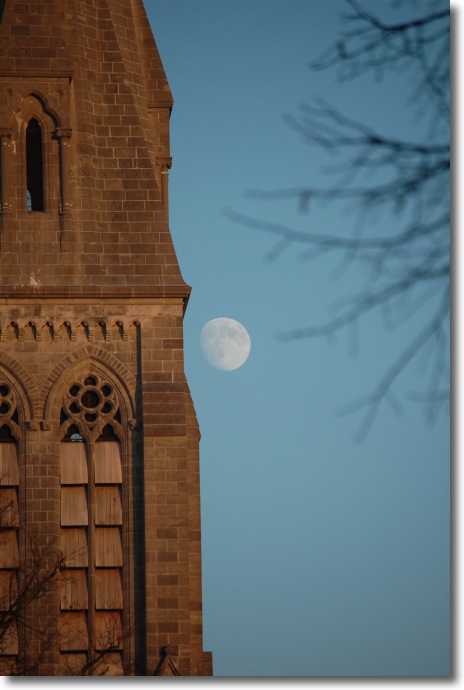
The Moon next to the spire of the Gunne Chapel at 200mm.
See What a Master Can Do
If you want to see just how great it can be to get the Moon into a landscape I’d strongly urge you to check out this link which shows what happens when you combine a Greek landmark with one of Europe’s best Astrohphotographers. Anthony doesn’t just show the shot but explains some of the considerations in it’s taking. When you read the note you’ll get a real insight into just how important timing and planning are for this kind of shot. The composition here is no accident, it’s completely planed and the shot took a lot of time and effort to get.







Hey Bart,
thanks for your interesting article. I usually get a few new Ideas from reading one of your photography posts. Some people might be saying that i’m taking fairly good shots myself but that’s more to having a good eye for things then having some technique. The latter I’m trying to work on and getting new Idea’s meaning mastering new types of subjects for photography and especially the moon is a quite interesting target.
Too bad I won’t be able to do any decent moon shot save by using that cropping trick… because I’m quite certain that none of the objectives for my Canon Powershot AS 570IS can do anything near 200mm. It isn’t a DSLR anyway (though one of the few non-DSLR digital cams which give you nearly as much control as a DSLR does, talking about shutter speed, ISO, Aperture length and co. )… but wouldn’t be calling photography a hobby if I wouldn’t’ be trying.
Looking forward to your next photography post bart! 🙂